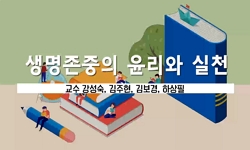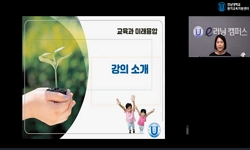The purpose of this study was to confirm the methods of respecting life shown in the folktale. Accordingly, this study explored how to protect life in 〈The Land that a Dead Son Has Children〉. The way to protect life began with the girl’s father....
http://chineseinput.net/에서 pinyin(병음)방식으로 중국어를 변환할 수 있습니다.
변환된 중국어를 복사하여 사용하시면 됩니다.
- 中文 을 입력하시려면 zhongwen을 입력하시고 space를누르시면됩니다.
- 北京 을 입력하시려면 beijing을 입력하시고 space를 누르시면 됩니다.

구비설화에 나타난 생명 존중의 한 방법, ‘신화적 아버지’ 만들기 = Creating a ‘Mythical Father’ as a Way of Respecting Life in Folktale
한글로보기부가정보
다국어 초록 (Multilingual Abstract)
Therefore, in this study, the story was understood with the girl’s parents as the ‘Subjects of Epic.’ Virgin pregnancy is socially unacceptable. So the girl is in danger of facing physical death. Even if she escapes the danger of physical death, she is socially stigmatized and has no choice but to die. Accordingly, from the perspective of the girl’s parents, the important thing is to save her and her child. She must be spared not only physical death but also social death. For this purpose, the girl’s parents made her child’s father appear to be a divine being. Creating a father, a divine being, is like giving a new narrative to a virgin. When she created a father, a divine being, her virgin daughter and baby were able to live in this world.
In the folktale, the problematic situation of a virgin’s pregnancy and the problematic situation of the loss of the family line organically meet. And through an implicit agreement between the two families, a woman who was almost socially buried can live in the world with her baby. It was created so that one could continue life in a situation where death was inevitable, and this can be called ‘creating a mythical father.’ We don’t know who the baby’s father actually is, but if a mythical father is found, the baby can live a successful life. When viewed in modern times, this kind of mythical father-making can be seen as a kind of social design. It can be said that the virgin’s parents created a way for women and babies to live through the social design of creating a mythical father.
The maiden’s family practiced a method of respecting life through the social design of ‘creating a mythical father.’ And this reason is applied to many stories that are passed down orally and is passed down as a way to practice respect for life.
The purpose of this study was to confirm the methods of respecting life shown in the folktale. Accordingly, this study explored how to protect life in 〈The Land that a Dead Son Has Children〉. The way to protect life began with the girl’s father.
Therefore, in this study, the story was understood with the girl’s parents as the ‘Subjects of Epic.’ Virgin pregnancy is socially unacceptable. So the girl is in danger of facing physical death. Even if she escapes the danger of physical death, she is socially stigmatized and has no choice but to die. Accordingly, from the perspective of the girl’s parents, the important thing is to save her and her child. She must be spared not only physical death but also social death. For this purpose, the girl’s parents made her child’s father appear to be a divine being. Creating a father, a divine being, is like giving a new narrative to a virgin. When she created a father, a divine being, her virgin daughter and baby were able to live in this world.
In the folktale, the problematic situation of a virgin’s pregnancy and the problematic situation of the loss of the family line organically meet. And through an implicit agreement between the two families, a woman who was almost socially buried can live in the world with her baby. It was created so that one could continue life in a situation where death was inevitable, and this can be called ‘creating a mythical father.’ We don’t know who the baby’s father actually is, but if a mythical father is found, the baby can live a successful life. When viewed in modern times, this kind of mythical father-making can be seen as a kind of social design. It can be said that the virgin’s parents created a way for women and babies to live through the social design of creating a mythical father.
The maiden’s family practiced a method of respecting life through the social design of ‘creating a mythical father.’ And this reason is applied to many stories that are passed down orally and is passed down as a way to practice respect for life.
참고문헌 (Reference)
1 홍나래, "희생명당 풍수설화에 나타난 구복(求福)행위의 의미와 결과에 대한 일고찰 -‘사자생손형(死子生孫型)’, ‘유복자삼정승형(遺腹子三政丞型)’, ‘재취후손형(再娶後孫型)’을 중심으로-" 한국고전연구학회 (27) : 141-175, 2013
2 "한국구비문학대계 전82권"
3 서대석, "한국 신화의 연구" 집문당 2002
4 강성숙, "풍수발복설화에 나타난 발복의 양상과 그 의미" 17 : 29-52, 1999
5 신동흔, "코로나 위기에 대한 신화적·인문학적 성찰: <손님굿> 신화 속 질병신의 속성과 인간의 대응을 중심으로" 인문학연구원 83 : 167-225, 2020
6 김만태, "음택풍수의 명당발복 설화를 통해 살펴본 우리 풍수문화 -― 인식론적 관점을 중심으로 ―" 실천민속학회 15 : 5-45, 2010
7 김혜미, "설화 <하룻밤 인연의 아버지 찾은 아들>과 애니메이션 <니코>에 나타난 아버지 부재와 자녀의 정체성 탐색 양상" 한국문학치료학회 27 : 387-419, 2013
8 신동흔, "살아있는 한국신화" 한겨레 2014
9 임동혁, "사회문제 해결을 위한 사회적디자인 적용에 관한 연구" 단국대학교 2017
10 정운채, "문학치료학의 서사 및 서사의 주체" 3 : 315-335, 2010
1 홍나래, "희생명당 풍수설화에 나타난 구복(求福)행위의 의미와 결과에 대한 일고찰 -‘사자생손형(死子生孫型)’, ‘유복자삼정승형(遺腹子三政丞型)’, ‘재취후손형(再娶後孫型)’을 중심으로-" 한국고전연구학회 (27) : 141-175, 2013
2 "한국구비문학대계 전82권"
3 서대석, "한국 신화의 연구" 집문당 2002
4 강성숙, "풍수발복설화에 나타난 발복의 양상과 그 의미" 17 : 29-52, 1999
5 신동흔, "코로나 위기에 대한 신화적·인문학적 성찰: <손님굿> 신화 속 질병신의 속성과 인간의 대응을 중심으로" 인문학연구원 83 : 167-225, 2020
6 김만태, "음택풍수의 명당발복 설화를 통해 살펴본 우리 풍수문화 -― 인식론적 관점을 중심으로 ―" 실천민속학회 15 : 5-45, 2010
7 김혜미, "설화 <하룻밤 인연의 아버지 찾은 아들>과 애니메이션 <니코>에 나타난 아버지 부재와 자녀의 정체성 탐색 양상" 한국문학치료학회 27 : 387-419, 2013
8 신동흔, "살아있는 한국신화" 한겨레 2014
9 임동혁, "사회문제 해결을 위한 사회적디자인 적용에 관한 연구" 단국대학교 2017
10 정운채, "문학치료학의 서사 및 서사의 주체" 3 : 315-335, 2010
11 정운채, "문학치료 서사사전 3" 문학과치료 2008
12 정운채, "문학치료 서사사전 3" 2589-2873, 2008
13 이수자, "구비문학에 나타난 부친탐색 원형" 한국구비문학회 (28) : 205-240, 2009
14 정충권, "구비 설화에 나타난 가족 재생산과 혈연 문제" 한국구비문학회 (31) : 83-113, 2010
15 최래옥, "고목생화설화의 성격" 2 : 347-365, 1977
16 이지영, "<야래자설화>의 측면에서 본 <死者生孫說話>" 국어국문학회 129 : 1-15, 2001
17 이강엽, "<동명왕편> 소재 兩價物의 신화적 기능과 서사맥락에서의 의미" 한국고전문학회 (34) : 137-170, 2008
동일학술지(권/호) 다른 논문
-
『우리말샘』 등재어에 나타나는 강원 방언 혼종어의 조어 양상
- 강원대학교 인문과학연구소
- 왕효동
- 2023
- KCI등재
-
춘천 대룡산 화전을 통해 본 강원도 화전의 전개 과정과 특징
- 강원대학교 인문과학연구소
- 김세건
- 2023
- KCI등재
-
조선통신사와 일본의 군주 - 아라이 하쿠세키의 시도를 중심으로
- 강원대학교 인문과학연구소
- 황소연
- 2023
- KCI등재
-
- 강원대학교 인문과학연구소
- 박정민
- 2023
- KCI등재




 KCI
KCI DBpia
DBpia






